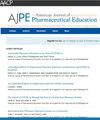美国药学教师与儿童的工作-家庭整合的观点。
IF 3.5
4区 教育学
Q1 EDUCATION, SCIENTIFIC DISCIPLINES
引用次数: 0
摘要
目的:探讨有18岁以下受抚养子女的美国药学教师工作-家庭和家庭-工作冲突的原因。方法:采用Zoom软件对来自美国药学院的教师进行半结构化定性个人访谈。问题集中在工作-家庭冲突、家庭-工作冲突、工作-家庭融合的最新变化以及改进策略。访谈录音,转录,并使用主题内容分析进行分析。结果:纳入42个访谈进行分析,代表37个独特的机构。运用改良的社会生态框架,建立了一个理论模型,说明了三个核心结构之间的关系:1)障碍和促进因素,2)工作-家庭整合,以及3)影响。参与者确定的障碍包括正常工作时间以外的工作承诺,缺乏工作灵活性,父母和孩子之间的学术日历冲突。促进因素包括自主性、伴侣支持、工作中的同伴支持、边界设置和工作与生活融合的意向性。个人、人际、组织和社会层面的障碍和促进因素塑造了参与者实现工作与家庭融合的能力,并造成了压力、内疚、紧张的关系、工作场所联系减少等影响,在某些情况下,考虑离开学术界以获得更好的工作与生活平衡。与会者建议采用灵活的工作政策、支持性领导和有意的组织战略来促进工作与生活的融合。结论:工作与生活的整合是有受抚养子女的药学教师面临的关键问题。个人、合作伙伴、同事、雇主、机构和学院应该提供有意的支持,帮助教师实现可持续的工作与生活的融合。本文章由计算机程序翻译,如有差异,请以英文原文为准。
Perspectives on Work-Family Integration Among U.S. Pharmacy Faculty With Children
Objective
To explore the causes of work-family and family-work conflict among US pharmacy faculty with dependent children under the age of 18.
Methods
Semistructured qualitative individual interviews were conducted via Zoom with faculty members from US schools/colleges of pharmacy. Questions focused on work-family conflict, family-work conflict, recent changes to work-family integration, and strategies for improvement. Interviews were audio-recorded, transcribed, and analyzed using thematic content analysis.
Results
Forty-two interviews were included for analysis, representing 37 unique institutions. A theoretical model was developed using a modified socio-ecological framework, illustrating the relationship among 3 central constructs: (1) barriers and facilitators, (2) work-family integration, and (3) impact. Participant-identified barriers included work commitments outside of normal business hours, lack of work flexibility, and conflicting academic calendars between parent and child. Facilitators included autonomy, partner support, peer support at work, boundary setting, and intentionality toward work-life integration. Barriers and facilitators at the individual, interpersonal, organizational, and societal levels shaped participants’ ability to achieve work-family integration and contributed to impacts such as stress, guilt, strained relationships, diminished workplace connections, and, in some cases, consideration of leaving academia for a better work-life balance. Participants recommended flexible work policies, supportive leadership, and intentional organizational strategies to promote work-life integration.
Conclusion
Work-life integration is a critical issue for pharmacy faculty with dependent children. Individuals, partners, coworkers, employers, institutions, and the Academy should provide intentional support to help faculty achieve sustainable work-life integration.
求助全文
通过发布文献求助,成功后即可免费获取论文全文。
去求助
来源期刊
CiteScore
4.30
自引率
15.20%
发文量
114
期刊介绍:
The Journal accepts unsolicited manuscripts that have not been published and are not under consideration for publication elsewhere. The Journal only considers material related to pharmaceutical education for publication. Authors must prepare manuscripts to conform to the Journal style (Author Instructions). All manuscripts are subject to peer review and approval by the editor prior to acceptance for publication. Reviewers are assigned by the editor with the advice of the editorial board as needed. Manuscripts are submitted and processed online (Submit a Manuscript) using Editorial Manager, an online manuscript tracking system that facilitates communication between the editorial office, editor, associate editors, reviewers, and authors.
After a manuscript is accepted, it is scheduled for publication in an upcoming issue of the Journal. All manuscripts are formatted and copyedited, and returned to the author for review and approval of the changes. Approximately 2 weeks prior to publication, the author receives an electronic proof of the article for final review and approval. Authors are not assessed page charges for publication.

 求助内容:
求助内容: 应助结果提醒方式:
应助结果提醒方式:


